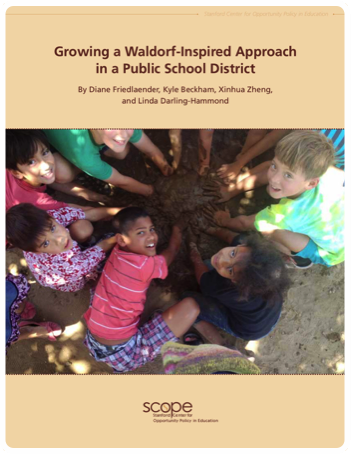Independent Partnership ?

A research paper published in 2015 is currently making the rounds: “Growing a Waldorf-Inspired Approach in a Public School District”
It is an analysis of the benefits of a Waldorf-inspired education in the Sacramento City Unified School District (SCUSD). What is getting people excited is how positive this research is about the outcome of integrating the Steiner-Waldorf pedagogy into the school system:
“Particularly powerful are the examples of the ways the school attends to children’s social-emotional, physical, artistic, and spiritual development and the integration of developmental domains. […]
“The types of school-based decision-making SCUSD provided for the [Alice Birney Waldorf-Inspired School], even those that were hard fought for, permitted Birney to have a far greater fidelity to the Waldorf approach than they would have been able to have without some control over curriculum, assessment, and staffing, in particular. That fidelity to Waldorf in turn led to high levels of student and parent satisfaction, demand for the school, and strong student outcomes.”

The researchers heap great praise on the Anthroposophical pedagogy, concluding that: “The Waldorf model is unique in its comprehensive nature, with its explicit theory of child development, curriculum, pedagogical approach, and philosophy about the role of the teacher. We do know that Birney students graduate with many skills often not addressed fully in other schools, such as creativity, love of learning, inquisitiveness, connection to nature, emotional intelligence, and many physical, artistic, and practical life skills.”
But skimming through this 129-page report reveals inconsistencies. Not in what they wrote, but in what the researchers left out. There’s no mention, for instance, of racism in the pedagogy, nor of Anthroposophy’s belief in karma, reincarnation, angels, and demons, and how this affects the way pupils are treated, sometimes to great detrimental effect.
The report repeats the same misleading reassurance that “though the philosophy of anthroposophy is the backbone of much of the Waldorf approach to schooling, it is not directly taught to children”. Indeed, Anthroposophy isn’t taught directly and there are no classes on the subject, but it permeates the very fabric of every Steiner-Waldorf school. As such it inevitably has a strong influence on the staff, and therefore the pupils in their care.
The only two comments on bullying fly in the face of what we’ve been reporting over the years. For instance, a parent from Alice Birney Waldorf-Inspired School stated: “It is a whole lot less Lord of the Flies here....That there is, from day one, an alternative presented to the children, that first we figure it out yourself by using words, and that we do not resort to physical pushing or bullying, and honestly, I haven’t seen any of that, or really heard about it at this school.”
And a student from George Washington Carver Waldorf High School said: “I had a cool social life, but I mean there weren’t large instances of bullying. There weren’t like super cliques. There wasn’t any bullying of the queer kids, and we all just got [along]”
Compare this to allegations of “mobbing, restraining, even physical violence” at the Rudolf Steiner Schule Aargau in Switzerland, or to the UK’s Aberdeen Waldorf School closing because of bullying complaints. More accusations of bullying were reported at Canada’s Kelowna Waldorf School, at the Te Ra Waldorf School in New Zealand, at Switzerland’s Ecole Rudolf Steiner de Lausanne, and the UK’s Ofsted education inspectors recently viewed Steiner Schools as unsafe and inadequate. There’s also our own detailed and evidential case of bullying at New Zealand’s Titirangi Rudolf Steiner School where the bully in question later admitted to raping three minors at the other Steiner school he was moved to. And this case of sexual abuse isn’t an isolated one as the reports of the US’ Green Meadow Waldorf School, Canada’s Toronto Waldorf Academy, and India’s Tridha Steiner School show.
Something clearly doesn’t quite add up.
Thankfully, research such as this has to be transparent, and a potential reason for this discrepancy was found in the Acknowledgements: “this project was funded by Steiner College.”
Now of course the writers stress very clearly that “the research and findings in this report were conducted independent [sic] of the funder”, yet on the very next page they state that not only are they “deeply grateful” for Steiner College’s “generous financial support but also for the encouragement and partnership in this important work”.
Now, how can the results of any research be independent of the funder if the funder is also an encouraging partner in the research?…

Related Articles
The Myth of the Top of the Tree
Evolving Along Hierarchical Races
The Karmic Burden of Vaccination
The Lure and Appeal of a Low-Tech Steiner-Waldorf Education
The Problem Child - Dealing with Dyslexia
Ecole Rudolf Steiner de Lausanne
School Closure Amid Bullying Complaints
Fundamentalism Shrouded in Friendliness
Accused of Being a Violent Cult
The Inadequacy of British State-Funded Steiner Schools
Titirangi Rudolf Steiner School
`Sexual Abuse in Green Meadow Waldorf School